The Rev. Herbert Mulholland
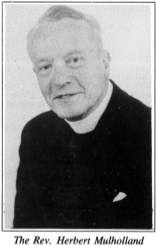 The
Rev. Mulholland was born in Balnamore on the 18th of June 190 His
father and mother moved Ballymena where he grew up. He was brought up
in connection with We Church, Ballymena. As a young man he came
under the influence of the Re W. P. Nicholson, an evangelist of
those days. As the result of a spiritual experience he decided at
one of his services to study to be a minister Ultimately he was
licensed by the Ballymena Presbytery on 27th May 1932. The
Rev. Mulholland was born in Balnamore on the 18th of June 190 His
father and mother moved Ballymena where he grew up. He was brought up
in connection with We Church, Ballymena. As a young man he came
under the influence of the Re W. P. Nicholson, an evangelist of
those days. As the result of a spiritual experience he decided at
one of his services to study to be a minister Ultimately he was
licensed by the Ballymena Presbytery on 27th May 1932.
The Rev. Hebert Mulholland was called to
Banbridge Road at a Congregational meeting held on 1st September,
1932. In spite of the background of the previous years when the
congregation was very deeply divided he received a unanimous Call
and was ordained on the 29th September.
The service of Ordination Banbridge Road was
conducted by the Moderator of Presbytery, the Rev. H McKinty. The
Rev. H. C. Clements Ballysillan where Mr Mulholland had been
assistant, also took part, as did the Rev. R. S. Craig, his home
minister. The Charge was given by the Rev. H. Orr of Hillsborough.
It is worth while to record two quotations from that address.
The Rev. Orr said to the young minister "Do the
work of an evangelist. That after all is your chief task. The longer
I live, the more convinced I am that every minister should be his
own evangelist and that we should refuse to allow this most
important part of our work to be done by visiting evangelists,
called in for the purpose like a consulting physician at a crisis.
It may be argued of course that every minister does not possess the
evangelistic gifts. That may be true as far as preaching is
concerned, but it implies a very limited understanding of the
subject. Evangelism is a far wider thing than mere pulpit utterances
and you will probably find as time goes on that the best
evangelistic work is done outside the pulpit altogether - in your
Bible Class for instance, or in the homes of your people, or best of
all in your friendship with your members."
The other quote is: "What is called the `pastoral
visit' perhaps was never less popular with us than now. Most
ministers don't like it and yet I say it is an essential preparation
for the Sunday for in that way and only in that way will you get to
know your people and their needs in a way that would be impossible
by simply gazing at them from the pulpit. I need not remind you of
the importance of knowing your homes."
Mr Mulholland, in his address, thanked the
congregation for the greatest honour that any congregation could do
for any young man. He made no promises about what he would do, but
he assured them that all his work would be for the good of the
congregation. There were many present, states a press report, who
were deeply impressed by the `obvious enthusiasm' and 'sincerity' of
the young minister.
The Rev Mulholland was a bachelor for six years
after he came to Dromore; his sister Eileen acting as his
housekeeper. She served in the W.R.N.S. and later she became Matron
of the Presbyterian Hostel in Belfast. On the 8th September 1938 he
married Miss E. Currie, who very quickly won the hearts of the
people. The minister took his wife round the families as was
expected in those days. He himself did a "round of pastoral visits"
yearly throughout his ministry.
Mr Mulholland, as be began his ministry in
Banbridge Road, was very conscious of the lingering divisions in the
congregation. He decided not to be involved and that enabled him to
carry on with his work for all the people. He was the right man at
the right time.
The new hall, like many new halls at that time,
was used for the Sunday School work and that was all. There was a
small room upstairs at the back of the hall and the Committee used
this for their monthly meeting. Eighteen months after the opening
the first request for the use of the hall came before the Session.
Some young people asked to be allowed to start a Badminton Club.
This was granted on the condition that the property would not be
injured and that play would be over by 10 o'clock. This proved a
very successful club and apart from the war years, was active until
the present time.

The minutes of Session and Committee reveal
nothing startling - mostly routine business, the Session receiving
new ccmmunicants twice a year, the Committee passing accounts and
looking after the property. Much more revealing are the Annual
Church Reports with their inclusion of the Annual Reports of the
organisations and societies.
By 1933 there was a very successful Girls'
Auxiliary and a Junior branch with a total membership of fifty. In
1934 a Ladies' Work Class commenced.
They applied themselves to helping to clear the debt on
the hall, which was about �48. As the result of a sale of work over �110
was raised (a very large sum in those days). How much this congregation
owes to its ladies who again and again over the years ahead came to its
rescue.
By 1937 the Work Class had become the Work Guild. A
Boys' Auxiliary was started in 1942 the first report being given at the
next Congregational meeting by Cecil Whan, who for many years played an
important part in the Auxiliary. In 1943 it was united with First
Dromore branch. After a number of very successful years the union was
broken. The Girls' and Boys' Auxiliaries had a very definite missionary
slant and were a very important organisation in many congregations. In
Banbridge Road the senior branches closed down in 1949, as did the
Junior B.A., the Junior G. A. continuing for a time. The reason for this
will become clear later.
In 1939, when war was declared, the hall was
commandeered by the Army and the men of the 202 Field Ambulance (who
came mostly from Wrexham) were in it for a long period. Shortly after
the soldiers arrived a canteen was proposed. This was held in the old
Masonic Hall in Church Street. The churches co-operated in this venture,
Mrs. T. B. Wallace being the Chairperson. There was, it is said, no lack
of help, ladies old and young volunteered to take their turn. Mrs.
Mulholland tells how one evening in early February snow began to fall
and Mr. Mulholland went down to meet his wife at the canteen. With
difficulty they made it home to find that there was no water and so it
continued for six weeks. The author can testify to a similar experience
on a number of occasions. Water to the manse was a problem for many
years. The house was on a hill and at the end of the pipe line.
In those days there was always a number of soldiers
at church. The manse was an open door on Sunday evenings, any soldier
could call for a chat and a cup of tea.
At the time the Church hall was built a Memorial Gate
to the grounds was presented by Mr. George Ervine, who had been co-opted
an elder from Magherally in 1930. This gate became a source of
controversy with the Ministry of Finance during the Second War. Metal
railings and gates were by law commandeered to help with the war effort.
However, railings and gates of Church property were excluded. Immunity
did not extend to the railings and gates of a church hall. Because the
Ervine Gate was a memorial and the taking away of the railings would
have left the hall very exposed it was decided to challenge the
decision. After some months of correspondence the following letter (see
page 41) was received from the Minister of Finance. That, it would seem,
was the end of the matter, and the Memorial Gate.
A united Christian Endeavour was active at that time,
First Dromore and the Methodist congregations along with Banbridge Road
sharing the responsibility.
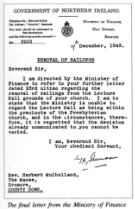 Mr.
Mulholland joined the Home Guard and was made a Sergeant and coped well
with the training. Mr.
Mulholland joined the Home Guard and was made a Sergeant and coped well
with the training.
The Rev. Mulholland received a call to Moseley,
Birmingham, in October 1945. From there he moved to St. John's Wood,
London, and then to Derby where he stayed until his retirement in 1971.
He and his wife came back to Ireland in 1974 to be nearer their kin. Mr.
Mulholland died on the 5th June 1979. Mrs. Mulholland still resides in
Coleraine. In a recent letter she has at this time expressed her
interest in this history and her good wishes to the congregation.
It can be said without any fear of contradiction that
in spite of having taken up his ministry with the shadow of division
hanging over the congregation The final letter from the Ministry of
Finance and having years of the work of the congregation curtailed by
the occupation of the hall by the military, Mr. Mulholland preserved the
congregation, and his successor (the Author) many a time testified to
the fact that he inherited a congregation of loyal and united people.
Herbert Mulholland had played his part well.

The Rev. Hugh R. Moore�
Autobiography in the third person.
(When writing about oneself, one must strive to be
truthful. Truth is more important than modesty. The writer hopes he has
achieved both).
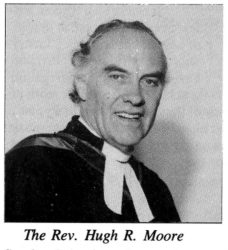 The
eighth minister of Banbridge Road was Hugh R. Moore, who was born on the
19th of the 9th month 1919. He grew up in Belfast and as a small child
went to Belmont Sunday School where his father taught. Afterwards when
the family moved to Cliftonville they joined Oldpark Church, which
belied its name by being on the Cliftonville Road. He went to the
Belfast Royal Academy. As a young teenager he attended a united mission�Oldpark
and Cliftonville congregations � conducted by Rev. Alexander Frazer of
Tain, Scotland. There he made a decision which was to influence the
whole course of his life. At the time this happened he was thinking of
leaving school and going into his father's business, but in the light of
his experience he continued with his studies with a view to entering the
ministry. He entered Magee College, Londonderry, and graduated in Arts
in The
eighth minister of Banbridge Road was Hugh R. Moore, who was born on the
19th of the 9th month 1919. He grew up in Belfast and as a small child
went to Belmont Sunday School where his father taught. Afterwards when
the family moved to Cliftonville they joined Oldpark Church, which
belied its name by being on the Cliftonville Road. He went to the
Belfast Royal Academy. As a young teenager he attended a united mission�Oldpark
and Cliftonville congregations � conducted by Rev. Alexander Frazer of
Tain, Scotland. There he made a decision which was to influence the
whole course of his life. At the time this happened he was thinking of
leaving school and going into his father's business, but in the light of
his experience he continued with his studies with a view to entering the
ministry. He entered Magee College, Londonderry, and graduated in Arts
in
Trinity College, Dublin. His theological course was
taken at Assembly's College, Belfast. He preached on a list of six
(assistantships were scarce in those days) for an assistantship in
Ulsterville congregation � the remuneration was �2 a week (the going
rate at that time). However, he found his work in - Ulsterville very
rewarding in other ways.
The Rev. Hugh R. Moore As a teenager in Oldpark he
had been a Sunday School teacher, and a member in the 14th Belfast
Company of the B.B. He had also been assistant leader in the Life Boys.
With this background he played his part in the 34th Company of the B.B.
at Ulsterville. He was interested in physical fitness, and was put in
charge of P.E. When the time came to leave Ulsterville he did so with
regret. His large Sunday Afternoon Young People's Bible Class of over
100 and his B.B. work were a source of great satisfaction to him. He
loved the people, and the minister and his wife, the Rev. and Mrs. S. R.
Jamison, were staunch friends.
He preached for Banbridge Road early in January 1946
and received a unanimous Call, the Ordination and Installation taking
place on the 4th April. It was a happy day for the new minister and the
congregation, although no-one anticipated that the `marriage' would last
some 38 years. It was a happy `marriage' and for him the beginning of
many happy years in Banbridge Road.
At the reception on the day of his Ordination,
Mr. Moore, recalled how when he was a boy attending a Sunday School
social a young girl recited a poem, the recurring words of which
were `God has a plan for every man and he has one for you.' The new
minister looking back over the years said he now realized the
significance of those words.
Having paid tribute to his parents, his minister,
the Rev. J. Dunlop, his Sunday School teachers, his professors and
his friends, he had this to say of Ulsterville�If I had to spend my
assistantship days over again I would not wish to spend them in any
other congregation,' and he went on to pay high tribute to the Rev.
S. R. Jamison.
Mr. S. J. Duffy, the Clerk of Session, in his
welcome, said, "We have reason to believe that the settlement to-day
will be the prelude to many years of happiness and blessing both to
Mr. Moore and the congregation." The next 38 years, it can be safely
claimed, proved this to be true, for the minister at any rate!!

The following is an extract from a letter Mr.
Moore received from the Rev. Herbert Mulholland, his predecessor, a
few days after he received the Call. "You are a very fortunate young
man to start your ministry in Banbridge Road. My own ministry there
lasted 13 years, during which I had no worries, no quarrels, and no
unpleasantness of any kind. I say this not to take credit to myself
but rather to encourage you concerning the people you will have to
work with through the next years. You will get plenty of support and
plenty of friendship. You will understand that after 13 happy years
there my attachment to the place is very strong, as is my desire
that they should do well in the future." Mr. Moore often testified
to the truth of these words, and at the end of his much longer
ministry he was able to commend the congregation in a similar ,way
to his successor.
Mr. Moore was Moderator of the Presbytery on two
occasions 1962 and 1977 and in 1979 he was elected Moderator of the
Synod. He represented the congregation for a number of years on the
Committees of several rural schools. He was also on the Committee of
the Primary School in the town for most of his ministry and was a
foundation member of the Board of Governors of the High School upon
which he served for thirty years.
Mr. Moore was a year and four months in Banbridge
Road when he married Miss Ethel McNutt, who came from near Claudy,
County Londonderry. She was born in Didsbury, Alberta, Canada, where
her father had been a minister in the Presbyterian Church of Canada
before retiring, to return to Ireland to farm. Mrs. Moore trained as
a teacher at Victoria College. After settling down in the manse, Mr.
Moore and his wife paid a visit to every home�a demanding task, but
worthwhile as Mrs. Moore from the beginning knew the congregation as
well as her husband. They had three children, two girls and a boy,
and when the youngest reached school age Mrs. Moore took up her
profession again. After a time of `subbing' she was appointed an
assistant in Ballyvicknakelly Primary School and later became its
headmistress. When the school closed she became a peripatetic
teacher with the Southern Education Board from which she retired in
September 1984. The daughters are married and live in the area, the
son in Belfast.

While those who were present on the day of Mr.
Moore's Ordination may have been impressed by the Presbytery's
service, the lavish luncheon provided and the enthusiasm of the
welcome, no one could have been impressed by the state of the church
building. For over 30 years a major renovation had been
contemplated, but indecision, lack of money, and then during the war
the scarcity of materials and the war-time restrictions had made
this virtually impossible. Now with the war over, and a new
minister, the congregational Committee's first thoughts were `to get
on with' the long delayed renovation. More money seemed to be the
first essential. Mr. Moore was asked if he would pay a special visit
to each home to get pledges as to the extent of their financial
support. A letter was sent to every family indicating what was
proposed.
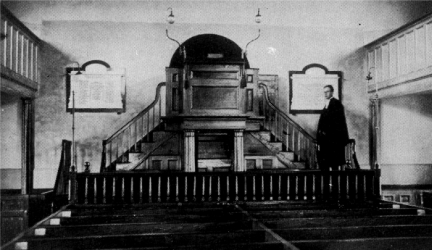
Banbridge Road Church
before renovation in 1953
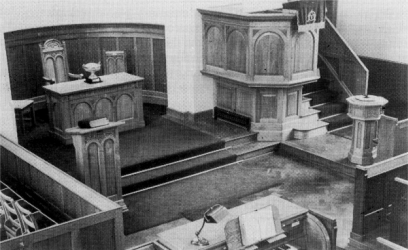
The Church after the
renovation 1953/4
Although the new minister did not anticipate such
an undertaking with any great joy, it was carried out and there was
a good response. The money given or promised, together with the
money already raised over a number of years, gave the Committee the
impetus to get on with this major undertaking. Later that year, Mr.
George Hobart, of Hobart and Heron, architects, who lived locally,
was asked to draw up plans.

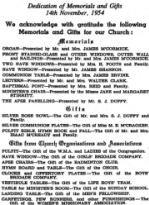 At
this time an application for permission to carry out the work was
lodged with the Clerk of the General Assembly. After the war only a
limited amount of structural work was permitted. Dr. Gailey, the
Clerk, informed the Committee that it would be the following year
before the congregation would get the required permit. Even a store
which was proposed in anticipation of the Church renovation, was
held up for a time by the Ministry of Finance. In the meantime Mr.
Hobart had plans drawn up and brought them to a meeting of Committee
held in December 1951. Mr. Hobart indicated that the work would cost
about �14,000 (it was to cost over �20,000) and that it was unlikely
that a permit for such a large amount would be issued. During the
next few months a number of Committee members visited various
churches to get ideas. In July 1952 final plans were drawn up and a
permit again applied for. It should be understood that in those
post-war years a certain amount of capital expenditure was allocated
by the Ministry of Finance to the Presbyterian Church, and this in
turn was allocated by the appropriate Assembly's Committee over
congregations. The Banbridge Road renovation was considered in those
days to be a `big job.' At
this time an application for permission to carry out the work was
lodged with the Clerk of the General Assembly. After the war only a
limited amount of structural work was permitted. Dr. Gailey, the
Clerk, informed the Committee that it would be the following year
before the congregation would get the required permit. Even a store
which was proposed in anticipation of the Church renovation, was
held up for a time by the Ministry of Finance. In the meantime Mr.
Hobart had plans drawn up and brought them to a meeting of Committee
held in December 1951. Mr. Hobart indicated that the work would cost
about �14,000 (it was to cost over �20,000) and that it was unlikely
that a permit for such a large amount would be issued. During the
next few months a number of Committee members visited various
churches to get ideas. In July 1952 final plans were drawn up and a
permit again applied for. It should be understood that in those
post-war years a certain amount of capital expenditure was allocated
by the Ministry of Finance to the Presbyterian Church, and this in
turn was allocated by the appropriate Assembly's Committee over
congregations. The Banbridge Road renovation was considered in those
days to be a `big job.'
Four tenders were submitted to the Committee by
Mr. Geo. Hobart on the 10th June 1953. The contract was ultimately
placed with Messrs. John Graham, a local firm. The work commenced in
the Autumn. An information letter was sent to each home setting out
the arrangements for the following twelve months. The hall was to be
specially arranged to create an atmosphere for worship; the Sunday
School was to have the use of five class rooms in the Primary
School. There were to be two Harvest Services both morning and
evening.
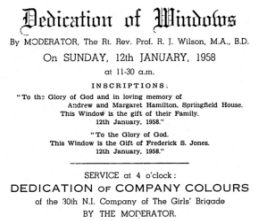 During
the next few weeks the church was literally gutted, the pews, the
gallery (which ran right round at that time) the ceiling and the
floor were taken out; just a shell with a roof remained. It was at
the same time a sorry and a glad sight. The following twelve months
saw many Committee meetings as inevitably changes had to be made and
decisions taken, often at short notice. During
the next few weeks the church was literally gutted, the pews, the
gallery (which ran right round at that time) the ceiling and the
floor were taken out; just a shell with a roof remained. It was at
the same time a sorry and a glad sight. The following twelve months
saw many Committee meetings as inevitably changes had to be made and
decisions taken, often at short notice.
Two interesting matters are worth a mention. When
the new gallery was taking shape the Committee felt that the front
was too high and boxlike, besides those sitting in it would not be
able to see the front of the church at ground level. Under pressure
from the Committee the contractor decided to lower the front by a
few feet. This was quite an undertaking. The gallery had to be
raised on jacks, the tops cut off the steel stanchions and the steel
beam that ran along the front of the gallery lowered into its new
lower place. It was successful, and while this was a great
improvement it was still felt by the Committee that it was too high
at the front; however, nothing more could be done.
The other notable matter was the ceiling. The
plasterers decided that to make a good job of the ceiling it would
have to be floated in one period of' time. So they began one morning
and worked all day and all through the next night until the next
evening, 36 hours non-stop. It proved an excellent job. The foreman
plasterer, John Calder, was a member of the congregation and wanted
the best; he also designed the rosettes on the ceiling and was
responsible for the fluting and other plaster work in the Apse. Work
well done!
The design of the furnishings was important. Many
of the items were to be memorials so they had to please the donor
and at the same time blend in with the redesigned building. The
Communion Table, the Pulpit, the Baptismal Font and the Reading Desk
have always been praised for their workmanship and design. Gradually
the building began to take shape. Many members and all the
organizations offered to pay for gifts, furnishings, windows and
carpeting. The most generous gift was of course the Memorial Organ,
valued to-day at nearly �30,000.

As the end came in sight, oh how slowly! there
was great enthusiasm and great disappointment�the church would not
be ready for the Harvest Services, besides it would be difficult to
hold the Harvest Services and the reopening in the same month. It
was decided to ask the other churches to allow the congregation to
come out of the harvest rota and to have its harvest services in
September and then to have the opening and dedication in November.
This plan worked out well and had the good will
of all. The opening services were to take place over a period of
four Sundays with a target of �5,000�a very large sum at that time.
By the end of November the target was reached with. the help of
several substantial contributions. It was a time of great rejoicing
and gratitude. The members were proud of what had been achieved. For
months there were visitors and friends and former members at every
service to see the renovated and refurbished church. The photographs
before and after give some idea of the change that took place.
The Re-opening Services were held on the 14th
November, 1954. Prof. R. J. Wilson, M.A., B.D., dedicated the
Memorial Organ and the other gifts (see list). Three of the windows
were also memorials and a fourth window was the gift of the Girls'
Brigade.
Four years later The Rt. Rev. Prof. R. J. Wilson
was back, this time as Moderator, to dedicate the two remaining
windows�one a memorial and one a gift.
MINOR HALL AND NEW KITCHEN
With the renovation over it seemed at the time to
the Committee and the members that they could rest on their oars.
Not so. The congregation was growing and the organizations were
expanding and soon it was realized more accommodation was needed.
The original hall kitchen was inadequate and a minor hall was
needed.
As soon as the debt on the church was cleared the
Committee concentrated on a scheme to provide a suitable extension.
The new building was ready by September, 1961, and dedicated on the
7th by the Right Rev. W. A. A. Park, M.A., D.D., the Moderator. The
opening ceremony was performed by Mrs. Emily McCormick. The
Presbytery's good wishes were conveyed by the Moderator, the Rev.
Hugh Young, B.A., and the greetings of the local churches by Canon
C. H. E. Clayton, M.A. The Committee and congregation were well
pleased with another successful project. Pleased as they were the
Committee and the congregation could not sit back and say `That's
it.'
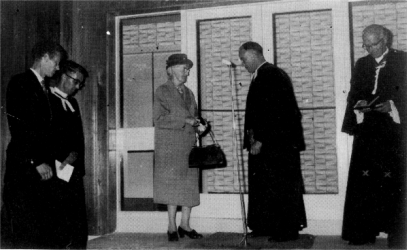
The opening of the Minor
Hall and new kitchen by Mrs. Emily McCormick

It was a time of considerable increase in the
congregation and over the next few years there were greater demands
on the accommodation. The main hall needed to be extended and a
proper stage constructed. By the mid seventies this was under
serious discussion and by 1978 the Committee had decided to go ahead
with another major extension. It was decided to extend the hall
backwards and build a new area embracing a large stage, a small
hall, cloak rooms, new toilet facilities and a shower. It was an
ambitious scheme involving some difficult construction work. Plans
were drawn up by Jim Cargin, a member of Committee, who played a big
part in supervising the work when it commenced. It was a job worth
doing and proved very valuable. A typical comment after it came into
use was, `How did we ever do without it.' On the 12th March, 1969,
four tenders were submitted, the lowest being �9,740, from the
McKeown Brothers. This was ultimately accepted. The final cost of
the work was considerably greater as there were the inevitable
additions and changes. The work was well done and the opening was
arranged for Wednesday, 16th September, 1970. It was a fine
occasion. And the service was conducted by the Moderator of
Presbytery, the Rev. D. H. A. Watson, and there was an address by
the Moderator of the General Assembly, the Right Rev. Dr. J. L. M.
Haire, M.A., M.Th. In the course of the service a number of valuable
gifts were dedicated.
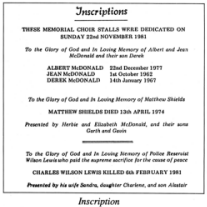 In
the life of any congregation there are many happy and congenial
occasions, but there are also those times of tragedy when the
whole congregation is as one in its sorrow; such a time was the
death of three innocent victims of terrorism, Mr. and Mrs.
William Herron and their daughter, Noeleen, on the 13th April,
1976. The whole town and many beyond were heartbroken. A fire
bomb in Mr. Herron's drapery shop in the Square set it on fire
in late evening and the family, who lived above the shop, were
overcome by the fumes. Every section of the community was
represented at the funeral. Hundreds stood outside the full
church. The three coffins resting on their trestles at the front
of the church were a sad sight for sad hearts. The Rev. Moore
had the assistance of a number of local ministers. In
the life of any congregation there are many happy and congenial
occasions, but there are also those times of tragedy when the
whole congregation is as one in its sorrow; such a time was the
death of three innocent victims of terrorism, Mr. and Mrs.
William Herron and their daughter, Noeleen, on the 13th April,
1976. The whole town and many beyond were heartbroken. A fire
bomb in Mr. Herron's drapery shop in the Square set it on fire
in late evening and the family, who lived above the shop, were
overcome by the fumes. Every section of the community was
represented at the funeral. Hundreds stood outside the full
church. The three coffins resting on their trestles at the front
of the church were a sad sight for sad hearts. The Rev. Moore
had the assistance of a number of local ministers.
In his address as well as expressing sympathy
to the bereaved family circle Mr. Moore condemned the horrific
deed in these words, ` What stuns � us all into shocked silence
is the thought that people could do this to their fellow human
beings with malice and forethought." The event was described in
the local paper as the worst tragedy to happen in the town in
living memory. The Herron family (two daughters Joy and Carol
and two sons Derrick and Alister) later presented the
congregation with an amplifying system for the church in memory
of their parents and sister Noeleen.
Another tragedy, which occurred on the 12th
November, 1981, evoked widespread sympathy in the congregation
and the community, Mr. Ronnie Pollock was severely wounded when
his car was blown up by a bomb as he was driving off from his
home. He survived this vicious attack, but lost his legs. He has
faced life with great courage and has had the sympathy and
encouragement of a wide circle of friends.

In 1981 a former member of the congregation,
Wilson Lewis, who was a Police Reservist, was shot. His wife and
family presented the congregation with two memorial choir
stalls.
And there were others who had grown up in the
congregation and left the area who were killed or maimed by the
ruthless enemies of our society.
Two other stalls were needed to complete the
refurbishing of the choir area, which had never been
satisfactorily furnished. These were presented by. Herbert and
Mrs. McDonald in memory of loved ones.
The memorial choir stalls were dedicated on
Sunday, 22nd November, 1981, by the Very Rev. David Burke, B.A.,
D.D. Apart from their memorial value they enhanced the front of
the church and are much more comfortable for the choir than the
chairs that had been previously used.
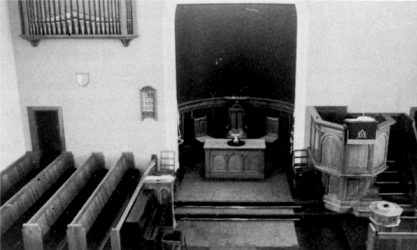
Memorial Choir
Stalls, 22nd November, 1981
 |